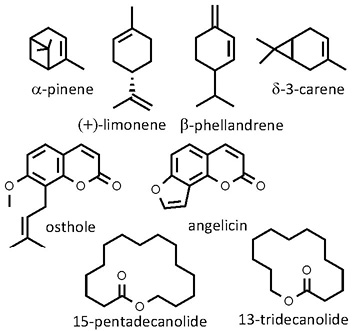 Angelica archangelica
Angelica archangelica
angelica
Back to “Salad herbs and herb mixtures: angelica (Angelica archangelica)”
Back to “Culinary herbs: angelica (Angelica archangelica)”
Back to “Spices: angelica fruits (Angelica archangelica)fr”
Angelica archangelica L. (Apiaceae); angelika (Afrikaans); angélique (French); Engelwurz (German); archangelica (Italian); angélica (Spanish); kvan (Swedish)
DESCRIPTION The thick, hollow young stems and leaf stalks and the dry, flat and ribbed fruits (schizocarps) are most often used in cookery. The spindle-shaped roots are the source of a valuable essential oil.1
THE PLANT Angelica is a robust biennial herb of about 2 m (ca. 6 ft) high when in flower. The hollow and fluted stems bear large leaves with toothed margins. Especially characteristic are the very large umbels of green flowers. Cultivated angelica may be confused with European wild angelica (A. sylvestris) or American angelica (A. atropurpurea), a purple-stemmed plant indigenous to North America) with similar uses.
ORIGIN Europe and Asia. The Vikings allegedly spread the herb to central and southern Europe from Iceland, Scandinavia and Russia. It has been cultivated in Europe and elsewhere as a culinary and medicinal herb for centuries, especially in monasteries. Angelica means “angel” and suggests divine healing power.1
CULTIVATION Angelica thrives in rich, well-drained soil with a slightly acidic pH. It is a hardy plant that can withstand even severe frost. It dies after flowering in the second year.1
HARVESTING Stems and leaves are usually harvested in the spring of the second year while roots intended for flavour use are dug up in the autumn of the first year.1 Flowering is sometimes prevented by pruning to prolong root growth. The fruits (seeds) are harvested when ripe.
CULINARY USES Stems, leaf stalks, roots, fruits and essential oil are used to flavour herbal teas and famous alcoholic beverages such as Benedictine, chartreuse, gin, vermouth and vespétro. The fresh leaves or leaf stalks are sometimes added to cream cheese, salads, sauces, soups, vegetables and meat dishes. Candied stems (traditionally produced in Niort in France)2 are used to decorate cakes and desserts. To make candied angelica, mature but green stem pieces are soaked in water, softened by cooking in sugar syrup and cleaned by removing the fibrous outer layer. The stem pieces become glassy and translucent when soaked for three days in boiling syrup. They are then dried in an oven and dusted with castor sugar.2
FLAVOUR COMPOUNDS The valuable essential oil obtained from the roots or the fruits has a musky, earthy odour and a pungent bittersweet flavour.1,4 It contains numerous mono- and ses-quiterpenoids, especially α-pinene, limonene, β-phellandrene and carene (δ-3-carene), as well as coumarins (osthenole, osthole and angelicin)3 and macrolides (especially 15-pentadecanolide and 13-tridecanolide).4 The musky scent is ascribed to the macrolides.

NOTES Angelica has appetite stimulant, stomachic and spasmolytic properties. Chinese angelica or dang-gui (A. polymorpha var. sinensis) is important in Chinese traditional medicine.
1. Farrel, K.T. 1999. Spices, condiments and seasonings. Aspen Publishers, Gaithersburg, USA.
2. Larousse. 1999. The concise Larousse gastronomique. Hamlyn, London.
3. Harborne, J.B., Baxter, H. 2001. Chemical dictionary of economic plants. Wiley, New York.
4. Nivinskiene, O., Butkiene, R., Mockute, D. 2003. Changes in the chemical composition of essential oil of Angelica archangelica L. roots during storage. Chemija (Vilnius) 14: 52–56.